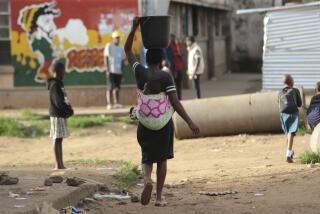Speaking Of. . . : Children
- Share via
Their lives are not what they could be.
True, the world’s progress in providing education and health care to children has been greater during the last 50 years than in the previous 2,000, says a recently released U.N. report. But that progress falls short of technology’s promise.
For instance, immunizations could eradicate most childhood scourges, such as polio, measles and diphtheria. But millions of children are not immunized. Poverty also exacts a toll. Malnutrition stunts the body and mind of one in three children living outside industrialized nations, says the report, “The State of the World’s Children 1994.”
In fact, the state of health and education among the young varies widely region to region.
Malnutrition
Malnutrition is a factor in one-third of the annual 13 million deaths of children under 5 years old. It is the most damaging in the mother’s last trimester of pregnancy and in the first year after birth, when brain development is nearing completion and the immune system is weak. Poorly nourished mothers tend to give birth to underweight, malnourished babies.
Percentage of infants with low birth weight (under 2,500 grams, or about 5 1/2 pounds):
Sub-Saharan Africa: 16%
Middle East and North Africa: 10%
South Asia: 34%
East Asia and Pacific: 11%
Latin America and Caribbean: 11%
Industrialized countries: 6%
Developing countries: 19%
Least developed countries: 24%
Education
Education is critical to the quality of life for children and their societies--enabling them to compete economically and to sustain democracies, among other skills. There have been greater gains here, but disparities persist by region and gender.
Gross primary school enrollment* 1960:
Boys Girls Sub-Saharan Africa 46 24 Middle East and North Africa 72 40 South Asia 77 39 East Asia and Pacific 120 85 Latin America and Caribbean 76 71 Industrialized countries 109 107 Developing countries 93 62 Least developed countries 48 23
Gross primary school enrollment* 1990:
Boys Girls Sub-Saharan Africa 76 60 Middle East and North Africa 103 87 South Asia 97 73 East Asia and Pacific 128 120 Latin America and Caribbean 105 102 Industrialized countries 103 103 Developing countries 107 92 Least developed countries 74 57
* The number of pupils enrolled in primary school, divided by the number of children of primary school age. Figures sometimes exceed 100 because some children enter primary school early or are enrolled beyond the typical age of graduation.
Health
Infant mortality has dropped, often dramatically, throughout the world. Immunizations and the technique of oral rehydration (continuously providing food and water to diarrhea victims) save millions each year. Still, there are major disparities. The United Nations’ goal for the year 2000 is for 90% of children to be immunized.
Percentage of 1-year-olds immunized around the world for polio:
Sub-Saharan Africa: 45%
Middle East and North Africa: 82%
South Asia: 83%
East Asia and Pacific: 92%
Latin America and Caribbean: 76%
Industrialized countries: 85%
Developing countries: 78%
Least developed countries: 51%
Number of infants per 1,000 who die before their first birthday:
Sub-Saharan Africa
1960: 152
1990: 111
Middle East and North Africa
1960: 155
1990: 57
South Asia
1960: 145
1990: 88
East Asia and Pacific
1960: 132
1990: 42
Latin America and Caribbean
1960: 105
1990: 39
Industrialized countries
1960: 36
1990: 9
Developing countries
1960: 137
1990: 70
Least developed countries
1960: 171
1990: 114
More to Read
Sign up for Essential California
The most important California stories and recommendations in your inbox every morning.
You may occasionally receive promotional content from the Los Angeles Times.












